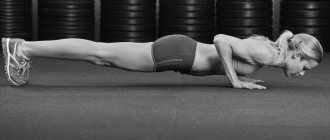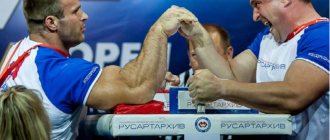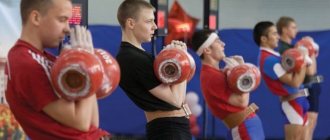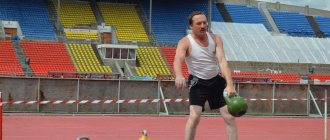| Emblem of the Kettlebell Lifting Federation |
| Weight-lifting |
|
| Theory |
|
| Inventory |
|
| Training |
|
| Competitive exercises |
|
| Preparatory exercises |
|
| Nutrition and recovery |
|
Source: “Kettlebell lifting. Training with kettlebells"
.
Management. Author:
instructor Pavel Tsatsoulin, 2015
A new minimum program for Russian kettlebell lifting. Summary[edit | edit code]
- Twice a week, alternate between swinging and jogging for 12 minutes.
- Don't overexert yourself. Only put yourself out there when you're ready.
- The purpose of running is to relieve muscle tension and remove lactic acid. Running is an active recreation.
- Twice a week, perform Turkish get-ups for 5 minutes, alternating hands.
- Focus on technique, not quantity. Don't count repetitions or increase their number.
- Approximate plan for the week: Monday, Thursday - swings; Tuesday, Friday - Turkish rises. Or Monday, Thursday - Turkish rises; Tuesday, Friday - swing. You can add a day for swings or Turkish get-ups.
- Pre-workout: 10 minutes of wall-facing squats, halo, and swings. See details.
- If you are still an inexperienced athlete, do not lift weights on your free days and read the article Kettlebell Training: Basics of Technique.
Preface about the author of the program
Pavel Tsatsoulin is a master of sports of the USSR, born on August 23, 1969 in Minsk, a former physical training instructor for Soviet special forces, now living in the USA.
In 1998, Pavel published his first article “Vodka, cucumber pickle, kettlebell lifting and other Russian entertainment” in MILO, a magazine for those interested in strength sports.
In 2001, Pavel’s book “The Russian Kettlebell Challenge” was published, and Pavel became a leading kettlebell lifting instructor in the USA. A few years later, the book “Introduction to Kettlebell Fitness” was published, and a little later, “Return to Kettlebells!” In the USA he is called the “King of Weights”.
Pavel worked as an instructor for the US Marine Corps, US Secret Service and Navy SEALs.
Step-by-step training plan with kettlebells[edit | edit code]
It is easy to take a variety of exercises as an end in itself, forgetting about the purpose of the training. In his book Weight Lifting
("Weight Lifting") Bob Hoffman wrote that for an ambitious person who does not do heavy physical labor... five workouts a week is enough to achieve best results.
The chart below is a classic weight training regimen. Athletes change the load in waves so that the muscles constantly respond to the training stimulus.
Distribution of training intensity per week:
- Monday – medium intensity workout.
- Tuesday - different exercises.
- Wednesday is a slightly harder workout than Monday.
- Thursday - different exercises.
- Friday is a day off.
- Saturday - training at the limit of strength.
- Sunday is a day off.
In the Hoffman program, you practice a variety of exercises on Tuesday and Thursday that are not done on core kettlebell days. On these days, practice, have fun, but don't push yourself. Work on what Marty Gallagher calls "intermediate strength," targeting parts of the body that aren't used in regular rows and presses. Do Turkish get-ups, mills, angled presses, juggling. Continue in the same vein, maintaining a schedule of pressing and deadlifting, but leaving in the schedule lighter days for different exercises. Not light, but lightweight.
Weekly training program with kettlebells:
- Monday - heavy bench presses and rows.
- Tuesday is a day off.
- Wednesday - light presses and deadlifts.
- Thursday - different exercises.
- Friday - medium presses and deadlifts.
- Saturday - different exercises.
- Sunday is a day off.
It is clear that you can create a training schedule for any number of days. Hoffman advises training with increased intensity on Saturdays. Others offer heavy, moderate, and light workouts on Monday, Wednesday, and Friday, respectively. In relation to Russian kettlebell lifting, the program could look like this.
You can move your hard workout to Wednesday or Thursday - these days are considered to be the days when you are best prepared for intense training.
- Monday - medium presses and deadlifts.
- Tuesday - different exercises.
- Wednesday is a day off.
- Thursday - heavy bench presses and rows.
- Friday - light presses and deadlifts.
- Saturday is a day off.
- Sunday - different exercises.
You can skip days with different exercises, but never skip light, medium or heavy training with presses and rows. Reschedule your workout if necessary, but don't skip it. If you are tired, overcome the fatigue. If you don't have time, skip a meal and work out instead. If you travel, take weights with you.
Workouts at home
Unfortunately, not everyone can afford to go to the gym regularly, mainly due to work and small children. However, not everything is as bad as it may seem; it has been established that there is no relationship between success in strength sports and the conditions where you train.
The main thing is that the exercises are performed in full and according to technique. Therefore, provide yourself with these conditions at home, and the result will be absolutely the same as if you worked out in the gym.
Calculation of the number of repetitions and working weight[edit | edit code]
The number of repetitions is selected purely individually, depending on the physiological characteristics and preferences of the athlete.
It is more convenient for people with an ectomorphic build to perform 12-15 repetitions with an average weight, although such athletes are usually recommended to train with maximum load. People with a strong physique (endomorphs), on the contrary, are advised to do at least 15 repetitions per set.
All this is true, but not everyone can train in an uncomfortable mode, and the athlete’s comfort often influences the results no less than the most correct training scheme.
If an athlete is used to training in the range of 5-8 repetitions per set, then the possibility of a minimal increase in repetitions will be a signal to increase the weight of the kettlebell.
So, if an athlete habitually performs 5-8 repetitions, then the ability to perform 9-10 repetitions will mean that the weight should be increased.
With the usual 8-14 repetitions, this limit can be 15-17 repetitions, and for 14-20 - 21-26 repetitions.
Cheating[edit | edit code]
Light cheating (lifting weights due to the inertia of the body) helps to effectively increase working weight in kettlebell training. In traditional bodybuilding, such techniques are considered very undesirable, since they disrupt the execution technique and disrupt the trajectory of the projectile, which can lead to injury. In addition, cheating provides virtually no benefits when performing isolated movements. But when working with kettlebells, the situation is different.
There is no technique for performing the exercise here initially. The athlete always presses or pulls the kettlebell in the way that is most convenient for him. The trajectory of the weight never deviates from the vertical, and the muscles are always loaded comprehensively.
Therefore, the negative properties of cheating have nothing to do with properly organized kettlebell training.
Exercises to develop coordination can be performed while training the corresponding muscles, or you can set aside a separate day for them. The main thing is that the athlete is prepared to perform this kind of exercise, that is, his muscles are actually in working condition and he knows how to control them.
When starting to train with weights, you need to record all the little things in your diary from the first days. In this case, within a couple of weeks it will be possible to understand the picture of what is happening and set realistic goals for the next month or two.
Since kettlebell training is designed to achieve exceptionally high performance, you should not waste your training time. Rest between sets should not exceed 2 minutes.
Training frequency[edit | edit code]
The frequency of training is selected based on two indicators:
- The muscles worked in a specific lesson must have time to recover (stop hurting). Unlike regular training with barbells and dumbbells, where most often an additional day or two of rest is added (and this is really necessary for isolated movements), in kettlebell (complex) training, rest days are practically not needed. For example, if the leg muscles recover in 4 days, then it makes sense to return to working them only on the 5th day, but on these days you can train any other muscle groups;
- The body must have time to restore the energy reserves wasted during training. Otherwise, you may overtrain.
Energy indicators must be recorded in a diary, constantly monitoring the overall tone of the body.
Intense physical activity leads to a noticeable increase in hormonal levels, and this makes you feel energetic. But when energy resources are depleted, the hormonal level in the blood drops sharply, which certainly affects the bodybuilder’s well-being.
If an athlete feels weak in the body, sleeps poorly and grimaces at the sight of sports equipment, then he clearly needs proper rest.
Training with kettlebells should be both a powerful jerk forward and, at the same time, a rest for the muscles from the usual movements. Each new cycle ideally promotes the renewal of nerve fibers that conduct signals to the muscles and forces them to adapt to sudden changes in loads. Muscles will have to increase the amount of energy they are accustomed to storing in case of unexpected physical activity. As a result, 1 month of working with weights should be a real breakthrough in the development of a bodybuilder.
And yet, the main thing for a bodybuilder is a constant increase in muscle mass. Different types of training provide variety and a guarantee of non-stop growth, so in no case should you limit yourself to any stereotypes. And there are many of them.
For example, there is a strong opinion that muscle mass grows only with a constant increase in working weight in a certain number of repetitions and sets, or, conversely, that pumping gives mass, and with heavy training there is a high probability of injury.
Any restrictions hinder full development, especially since muscles grow not thanks to the weight lifted, but to anabolic hormones released during intense training.
This means that hormones should be the main goal of working with hardware, and weights are an excellent method for significantly increasing intensity and, as a result, improving hormonal levels.
Kettlebell training cycles can last from 1 to 3 months. But bodybuilders achieve the best results with the following scheme:
- 4-6 weeks - weights;
- 8-12 weeks - dumbbells and barbell.
Safety precautions when exercising with weights
The kettlebell is a very dangerous projectile!!!
Calculate your ideal sports weight!
She shouldn't be underestimated. Unlike the barbell, which has fewer degrees of freedom - since the hands are interlocked with the bar - a rigid connection that limits the possible options for the movement of the barbell. This allows you to lift more weight.
But the weight is almost unlimited and can move wherever it wants. Those. except that we have to raise it. We still have to constantly control it with the help of small muscles.
Control deviations to the side and control twisting. After all, injuries caused by twisting are much more dangerous than others...
Exercises with a kettlebell are most often dynamic and therefore the impulse of the kettlebell is quite large, and taking into account the free one - i.e. its movement is almost unrestricted - we have a very heavy and therefore dangerous object at the end of our hand.
Our hand cannot hold the weight rigidly - like a barbell. The barbells on large bars - Olympic size with an end diameter of 50 mm - provide for free rotation of the load - there are bearings there to prevent injury to the hands of the practitioner.
And if the ends of the barbell stop rotating - on which the dialed weight disks are attached, then such a barbell is considered unsuitable for training.
The weights do not have any rotating parts. The weight is one piece. And our hand plays the role of a turning mechanism.
Training plan for deadlifts[edit | edit code]
On a draw day, roll the dice to determine the length of the round, from 2 to 12 minutes.
- Monday - light jerks. About 50-60% of what you could do if you went all out.
- Wednesday - medium swings. About 7080% of what you could do if you went all out.
- Friday (hard day) - heavy swings. Give your all in the allotted time.
You are challenged - move on to a heavier kettlebell.
Considering that the snatch is one of the goals, you may find it strange that it is performed only once a week and also in an easy mode. This is done for two reasons. First, your shoulders and elbows in your first year of kettlebell training are not prepared for a lot of jerking. Don't worry, light snatches plus heavy swings and presses add up to a load equal to the snatches on test day. Second, the Rite of Passage program involves a lot of pressing, and by the time you get to the rows, your shoulders will already be getting the load they need. And the snatch, as you may have noticed, depends heavily on the shoulders. Therefore, you will not only do snatches at half effort, but also after a light bench workout. If, even on an easy day, you notice that your snatch technique is deteriorating, end your workout by replacing snatches with high rows.
Sets and reps[edit | edit code]
And now, with the help of Anthony Diluglio, a master of Russian kettlebell lifting, let’s apply the boxing term “rounds” to kettlebells. Russian elite weightlifters measure workouts in minutes, not sets and reps. Anthony Diluglio and Steve Maxwell focus their gyms on time rather than sets and reps. People of different training levels can choose different training options without any problems. A beginner can do 50 snatches with a 16kg kettlebell in 5 minutes and be exhausted. Mutant Steve Cotter, a master of Russian kettlebell lifting, does 110 repetitions with a 32-kilogram kettlebell during the same time, and also gets tired: “Very intense, your legs give way, and your heart is pounding in your chest.”
Working against the clock allows you to get off the hook for sets and reps. Here's what Steve Kotter says: “30/30 rest, 10/10 rest, 10/10 rest, 6/4 time up. A total of 110 repetitions in 5 minutes. When I rest, I place the kettlebell on the ground. After the first approach I rest for only 15 seconds, after subsequent approaches - a little longer. My strategy is to do at least 60% of the planned number of repetitions in the first 2 minutes of the test. If I can get 80 reps under 3:30-3:45, I know I can do 100 reps, which I consider baseline for my current fitness level. For progressive overload, I will try to perform more reps in the first 2 minutes. Next time I'll do 32/32 and 12/12 in the first two sets, and then stay the same for the rest."
Through trial and error you will find your pace. Don't worry about the ideal rhythm of work and rest. Even experienced athletes do not always manage to maintain the golden mean. Russian kettlebell master Katherine Imes did 94 reps with a 24kg kettlebell in 5 minutes, an achievement many men would envy. However, Katherine was unhappy with herself: “20/20, 12/12, 10/10, 5/5... I probably could have done more reps on the first set, but I finished it too quickly - it took me about 1 minute . And I rested too long between the 10/10 and 5/5 sets. Next time I'll do more than 100 reps."
Russian kettlebell master Jared Savik, who performs 275 reps, advises: “Do quick sets of 10-20 reps, resting when needed.”
When resting between approaches, you should not slouch or rest your hands on your knees. New Zealander Robin McKenzie explains: “During loading, the joints of the spine are subjected to stretching, loosening effects, and structural damage occurs in them. After significant stress, the joints of the spine are easily susceptible to adverse changes if you hunch over while resting.”
McKenzie gives an example of how vulnerable a slouched and warmed-up athlete is. The long-distance runner “was so exhausted from the hard running that when he finished the race, he hunched over with his back hunched and his hands on his knees. He remained in this position for about two minutes, after which he felt pain in his back, which did not disappear even after he straightened up.” The runner "couldn't walk because of the pain in his back... and naturally he assumed that the pain was caused by running." As Rob Lawrence, a master of Russian kettlebell lifting, would say: “It’s your own fault.”
After performing deadlifts, do five to six backbends. Place your hands on your lower back, fingers pointing down, and bend back, using your hands as a fulcrum. Return to an upright position. With each subsequent repetition, try to bend a little more. Between snatch or swing sets, it's helpful to do some light exercises like shadow boxing.
But why roll the dice and rely on a random number from 2 to 12? Russian science of periodization teaches that an athlete should practice one exercise without changes for a certain period of time, and the load, intensity, volume should change from workout to workout. Effective training is “the same, but different.” The working exercises remain the same, but their intensity and volume are always different. Oleg Chelishchev, a Russian kettlebell lifting coach, emphasizes: “The workload should fluctuate like a sea wave, up and down, from a mirror-like surface to a storm.” The dice provide this opportunity: a two is smooth, two sixes are a storm.
Just from 2 to 12 minutes. It doesn't seem like much until you try it. Please note that the famous Tabata training lasts only 4 minutes and consists of periods of 20 seconds of work and 10 seconds of rest. “Only” 4 minutes. Keep in mind that those who have tried it on themselves never say “everything”.
If your shoulders or elbows hurt
As you already know, if your shoulders or elbows hurt, it's your fault. Something was done too much, too soon, too carelessly.
Use common sense to rehabilitate your shoulder or elbow. If the injury is minor and does not require medical intervention, do swings on a light day instead of snatches and replace presses with five minutes of Turkish get-ups according to the minimum program, as powerlifters say - pump up the injury.
If the spirit is stronger than the hands
Jared Savick, an American kettlebell champion, wrote on our forum: “Anyone familiar with kettlebells knows that jerking can cause damage to your palms, which can impact your workout.”
“I found a solution that puts a little more stress on the grip, but allows you to do 80-90% of your reps. These are fabric fingerless gloves. They will allow you to rotate the handle without harming your palms, and your free fingers will be able to hold the handle when jerking. If you want to work on your grip but don't like gloves or soap, try military wool gloves. This is another good and inexpensive tool.”
“Many gloves sold on the market are dotted with rubber. To keep it out of the way, just put the gloves on the other way around - with the dusting facing up.”
20 minute fat burning workout
Build muscle and burn calories by doing kettlebell exercises for all muscle groups. This will increase your calorie burn during exercise and will allow you to recruit more muscles in your body, which require a lot of energy to continue the fat burning process even after the workout ends.
Kettlebell lifting is one of the best ways to burn calories and strengthen your body, especially when you're pressed for time. You're guaranteed to get in shape with this 20-minute workout program.
How it works: Perform the exercises in order two or three times a week, resting 30-60 seconds in between. Do you have more than 20 minutes? Do another round, resting 1-2 minutes in between.
- Total time: up to 30 minutes.
- You will need: bench, chair, weights, mat.
Turkish get-ups with kettlebell
A. Lie on your back with your left knee bent and your right leg extended.
The left arm is extended to the side, palm down. Hold the kettlebell in your right hand, pointing it straight up. Engage your core and use your left hand to sit up, first moving onto your left forearm and then pressing into your left palm while keeping your right arm extended. B. Push your hips off the ground using your left arm and right leg, keeping your left leg extended.
C. In a quick, controlled movement, bring your left leg under your body and place it on your knee. Keep your right arm extended forward and your left arm extended above your shoulder.
D. Stand with your left foot next to your right, holding your right arm above your head and extending your left. Reverse the sequence to return to the starting position and take the kettlebell in your left hand to repeat on the opposite side. Continue alternating sides.
- Approaches: 1 - 2
- Reps: 16 – 20
Kettlebell swings
A. Stand with your feet hip-width apart and grasp a kettlebell with both hands. Bend at the hips and place your hands between your legs, keeping your knees slightly bent.
B. Push your hips forward and use lower body momentum to lift your arms to shoulder height, keeping the kettlebell pointing away from your body. Bend at the hips again and repeat the sequence, moving as quickly as possible while maintaining proper technique.
- Approaches: 1 - 2
- Reps: 16 – 20
Goblet squats with kettlebells
A. Hold the kettlebell with both hands at chest height, with your feet slightly wider than hip-width apart and your toes slightly pointed out to the sides.
B. Bend at the hips and knees as you lower into a squat, keeping your torso straight. Reverse the movement and repeat.
- Approaches: 1 - 2
- Reps: 16 – 20
Kettlebell push with one hand
A. Stand with your feet hip-width apart and grab the kettlebell with your right hand with an overhand grip. Push with one arm, bend your hips, and lower the weight back between your legs.
B. Push your hips forward and use your lower body to lift the kettlebell to shoulder height, bend your right elbow, and rotate your hand holding the kettlebell with your thumb toward your body. Allow your left arm to extend in front of your body at shoulder height.
C. Extend your right arm up over your shoulder, turning your palm away from your body and keeping your left arm in front at shoulder level. Reverse the movement, return to the starting position and repeat, switching hands on the next rep, quickly switching the kettlebell to your left hand and raising it to shoulder height. Continue alternating sides.
- Approaches: 1 - 2
- Reps: 16 – 20
Deadlift with kettlebell
A. With your feet hip-width apart, place a kettlebell on the ground between your legs. Bend at the hips, stretching the back. Keep your spine straight, push your hips back, and bend your knees slightly to grasp the kettlebell.
B. Squeeze your glutes and control the movement as you rise to a standing position, keeping your torso straight and the kettlebell close to your body. Reverse the movement and repeat.
- Approaches: 1 - 2
- Reps: 16 – 20
Bent-over row with one kettlebell
A. Stand with your right foot forward and your left foot back, holding a kettlebell in your left hand, placing your right hand on a chair or bench. Bend at the hips and slightly at the knees.
B. Keeping your torso straight with your shoulders and hips pointed toward the ground, extend your left elbow back, keeping it close to your body until your left arm is near your chest. Extend your left arm again and repeat 12-16 times, then switch sides and repeat.
- Approaches: 1 - 2
- Reps: 12 - 16
Training plan for the rite of passage into kettlebell lifting[edit | edit code]
Easy Monday
- Light clean and press combinations or military presses: five ladders with two fewer steps than on Saturday.
- Light Snatches: Roll the dice to determine the length of the round, and do about 50-60% of what you could do if you went all out. If your fitness is slipping, move on to upper rows.
Variety Tuesday (optional)
Do what you want, the main thing is that the load should be light.
Average Wednesday
- Medium clean and press combinations: five ladders with one step less than on Saturday.
- Medium Swings: Roll the dice to determine the length of the round, and do about 70-80% of what you could do if you went all out.
Variety Thursday (optional)
- You can do the first, second, or all three exercises listed below.
- Do a 5x5 ladder of power cleans, then move on to a 5x1 ladder of Turkish get-ups with a heavier kettlebell than used in ladders. Give yourself a five-minute rest between sets.
- Do 2-3 sets of 5-10 swings and/or 2-3 sets of 1-10 snatches with a heavier kettlebell than usual.
- Do what you want, the main thing is that the load should be light.
Friday - closed
Hard Saturday
1. Heavy exercise of cleans and presses: five stairs to the limit.
- Start your workout with a kettlebell that you can press 5-8 times.
- Do stairs for (1, 2, 3) reps.
- When you can do 5 x (1, 2, 3), add a fourth step.
- When you can do 5 x (1, 2, 3, 4), add a fifth step.
- When you can do 5 x (1, 2, 3, 4, 5), move on to a heavier kettlebell.
- Take your time between approaches and stairs.
2. Hard Swings: Roll a couple of dice to determine the length of the round, and make as many swings as you can within the time limit.
3. Every 4-8 weeks, replace your regular Saturday workout with a snatch and press test.
Sunday is a day off
Stick with this program until you can press a kettlebell half your weight with one hand and do 200 snatches of a 24-pound kettlebell in 10 minutes. They say that a person's strength of character is determined not by the severity of the difficulties he overcomes, but by their duration. It doesn't matter how heavy a weight you lift today if you quit working out in a month.
Helpful tips for effective training
♦ before performing exercises, always do a warm-up and cool-down to prepare all muscles for working with sports equipment;
♦ train with weights based on your capabilities, otherwise it’s easy to get injured. You shouldn’t grab 24 or 36 kg without preparation. looking at experienced athletes, remember that they also started with 8 kg;
♦ if you have experience as a weightlifter, then for men the optimal weight is 16-24 kg, and for women within 8-16 kg;
♦ when performing all exercises, avoid stooping, keep your back straight. When squats are performed, the pelvis goes back so that at the bottom of the squat, the knees do not go beyond parallel with the toes;
♦ perform exercises with a neutral grip of the hands; ideally, there should be no bends at all. To help, it is possible to use special clamps that hold the wrists in the desired position, which will help keep the joints healthy;
♦ all movements are performed with complete control; there is no need to jerk the weight until your joints crack. It may seem at first glance that experienced weight lifters are simply swinging the apparatus, but in fact they do everything strictly according to technique;
♦ if it is possible to train with 2 weights, then they must be of the same weight. This will allow you to load the left and right sides evenly, avoid developmental imbalances and reduce the likelihood of injury due to possible misalignment of the weight being lifted.
Recommendations for creating a training program[edit | edit code]
Some authors recommend changing your kettlebell training cycles every two weeks.
Marty Gallagher said that an ideal year of strength training consists of two 12-week competition cycles (meeting in week 13) and two 12-week off-seasons where a variety of exercises are practiced.
Alexey Faleev, master of sports and author of popular fitness programs in Russia based on powerlifting, alternates 4-5 months of strength training with 4-5 months of dynamic training.
- Train with the kettlebell training initiation program for 12 weeks, then gradually move on to a more professional program
. - You can practice one-arm push-ups and other exercises with your own body.
- To improve general physical fitness, add jumping rope and/or sprint intervals to your workouts.
Here is the sprint interval
, proposed by the USSR snatch test record holder: “Once a week I train for a minute, then rest for a minute as follows. I set the treadmill at 8 mph and the incline at 12. I hop on the side rails, set my watch, wait for the watch to read 0:59, then run for exactly one minute. When the clock shows 1:59, I jump off and start walking around the room to catch my breath. After about 30 seconds, I walk back to the treadmill, stand on the side rails, wait for the clock to read 2:59 so I can jump into place and repeat the process eight times. The workout takes about 17 minutes, then I have a smoke break. My legs become wobbly and I begin to feel bouts of vomiting. Believe it or not, my jerks come easier. I really feel that in order to do 250 to 280 repetitions for ten minutes, a person must have good heart function. I'm not a big fan of cardio, but for hardcore kettlebell training, it's essential. To put it simply, I run once a week for a total of 8 minutes and it helps.”
Naturally, such training should be carried out three times a week only if you do not do swings and jerks.
Abs workout
- Do 3-5 x 3-5 oblique exercises on the first day, such as Tuesday.
- Perform exercises for the rectus abdominis muscle 3-5 x 3-5 on the second day, for example on Thursday.
- These exercises are done after deadlifts, if you are doing them.
Where to buy weights
You may find something suitable nearby, but many of the ones sold in stores are very light. While this isn't a bad idea, it's better to invest in one or two heavier kettlebells; one with a large but adjustable weight that works well for all one-arm movements, and one slightly heavier for two-arm exercises (or one-arm, as you get stronger).
A beginner can choose a 12 or 14 kg kettlebell. If you're used to lifting heavy weights, you'll probably be better off with the 16kg weight, which is universal for both men and women. If you want something heavier, try the 24 kg weight. You will need it for full body exercises with both arms. One of the best brands is Rogue Fitness, they offer all weight options. If you're on a budget, or you're still not entirely sure whether weights are worth the investment for a beginner, try adjustable weight options.
The most unique aspect of kettlebell training is endurance. In addition to developing strength and muscle growth, you can work up a serious sweat with the endurance and cardio exercises included in our routine.
There are many workout variations you can do with kettlebells, and almost all of them target all muscle groups. Some people like isolation exercises, but for those of us who want to increase strength and endurance and lose excess fat.
Swing kettlebells from bottom to top
This kettlebell fitness exercise is an excellent cardio workout for those who want to lose weight. You just need to take a lighter projectile (8–12 kg). For those who prefer heavier weights, it will successfully replace the deadlift. When performed correctly, the muscles of the lower body are perfectly worked out: quadriceps, hamstrings, gluteals, as well as the muscles of the lumbar back. A good load is also given to the abs.
The starting position is as follows:
- stand up straight, feet slightly wider than shoulders,
- socks point to the sides at an angle of 45 degrees,
- feet pressed firmly to the floor throughout the entire exercise,
- the center of gravity is transferred to the heels,
- we move the pelvis back, while keeping the back straight,
- the gaze is directed straight ahead,
- the weight is on the floor between the legs.
On the count of one, we lift the weight off the floor with both hands and swing it back to the level of the buttocks. You can bend forward slightly, but the main thing is not to bend your back. On the count of two, we jerk forward using the muscles of the legs and buttocks. Inertia will direct the projectile upward, but this movement must be controlled. With the correct technique, the weight rises to chest level, and then, through the efforts of the deltoid muscles, is brought to the jaw line. Above is wrong!
On the reverse movement, the projectile reaches the level of the knee and is wound behind the heels. After which everything is repeated again. To control the movement of the kettlebell at each stage, it is not recommended to relax the buttocks at the top point. Also, you should not lift your heels off the floor, otherwise the heavy projectile may lead you to the side. And this is fraught with back injury. Therefore, it is better to start with small weights. The standard number of repetitions is 20–30.











